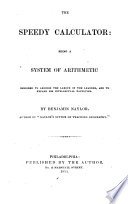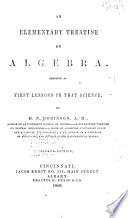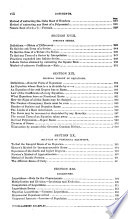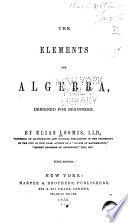 | Benjamin Naylor - 1850 - 334 pages
...product will be the last or greater extreme 2- — multiply the last term by the ratio, from the product subtract the first term, and divide the remainder by the ratio less one for the sum of the series, or raise the ratio to a power equal to the number of terms ; subtract... | |
 | Horatio Nelson Robinson - Algebra - 1850 - 256 pages
...rule for the sum of a series. RULE . — Multiply the last term by the ratio, and from the product subtract the first term, and divide the remainder by the ratio less one. GENERAL EXAMPLES IN GEOMETRICAL PROGRESSION. 1. What is the ratio of the series 2, 6, 18, 54,... | |
 | Arithmetic - 1851 - 260 pages
...nothing. Now let us consider the series as inverted ; then 6 will be the last term, and 3 the ratio. By the rule, multiply the, last term by the ratio, subtract the first term, and divide by the ratio, less 1. Here we have the sum of 6X3—0 the series, =9, the answer. EXAMPLES, 1 What... | |
 | Roswell Chamberlain Smith - 1852 - 298 pages
...Series, we have the following easy RULE. Mnltiply the last term by the ratio, from the prodnct snbtract the first term, and divide the remainder by the ratio, less 1 ; the qnotient will be the snm of the series reqnired. 9. If the extremes be 5 and 6400, and the ratio... | |
 | Arithmetic - 1853 - 266 pages
...^willing. 0 Now let us consider the series as inverted ; then 6 will be the last term, and 3 the ratio. By the rule, multiply the last term by the ratio, subtract the first term, and divide by the ratio, less 1. Here we have the sura cf 6X3—0 the series, =9, the answer. 35 EXAMPLES. 1 What... | |
 | Thomas Tucker Smiley - Arithmetic - 1854 - 192 pages
...is one less than the number of terms given. 3. Multiply the last term by the ratio; from the product subtract the first term, and divide the remainder by the ratio, less 1, for the sum of the series. Questions. What is Geometrical Progression? What is the ratio ? By what... | |
 | Elias Loomis - Algebra - 1855 - 356 pages
...already found, we shall have Ir-a Hence, to find the sum of the terms of a geometrical progression, Multiply the last term by the ratio, subtract the...first term, and divide the remainder by the ratio less one. If the series is a decreasing one, and r consequently represents a fraction, it is convenient... | |
 | Elias Loomis - Algebra - 1856 - 280 pages
...5= . (213.) Hence, .to find the sum of the terms of a geometrical progression, we have the following RULE. Multiply the last term by the ratio, subtract...first term, and divide the remainder by the ratio lesx one. Examples. 1. What is the sum of nine terms of the series 1, 3, 9, 27, 81, etc. ? We have... | |
 | Roswell Chamberlain Smith - Arithmetic - 1856 - 334 pages
...series, we have the following RULE. 21. Multiply the last term by the ratio, from the product subtrac the first term, and divide the remainder by the ratio, less 1 ; the qua tient will be the sum of the series required. 22. If the extremes be 5 and 6,400, and the... | |
 | Charles Guilford Burnham - Arithmetic - 1857 - 328 pages
...the series, we have the following RULES. I. Multiply the last term by the ratio, and from the product subtract the first term, and divide the remainder by the ratio less 1; the quotient will be the answer. II. Divide the difference between the two extremes by the ratio less... | |
| |